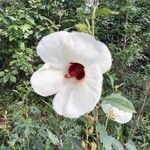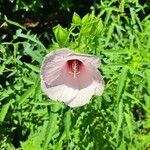Herbs, perennial, to 2.5 m, herbage glabrous or nearly so throughout. Stems often glaucous. Leaves: stipules caducous, linear-subulate, 2–10 mm; petiole 1/2 to somewhat exceeding blade; blade narrowly to broadly ovate or triangular-or lanceolate-ovate, usually hastately 3(–5)-lobed, sometimes unlobed, 6–18 × 3–16 cm, base cordate to truncate, lobes, especially middle one, ovate to triangular, to 3 times as long as wide, margins crenate-serrate to serrate or serrate-dentate, apex acuminate to long-acuminate, surfaces glabrous, nectary absent. Inflorescences solitary flowers in axils of distal leaves. Pedicels jointed distally, 1–10 cm, 1/3 to slightly exceeding subtending petioles; involucellar bractlets (8 or)9–15(or 16), linear-subulate, 1–3 cm, margins not ciliate. Flowers horizontal; calyx divided 1/3–1/2 length, broadly cylindric-campanulate, 2.5–3 cm, conspicuously larger in fruit, lobes broadly triangular, apices acute, surfaces glabrous, nectaries absent; corolla broadly funnelform, petals pink to white, red basally, obovate, 5–8 × 2–5 cm, apical margins entire to repand, finely hairy abaxially where exposed in bud; staminal column straight, pale pink to white, 2.5–4 cm, ca. 1/2 as long as petals, bearing filaments nearly throughout, free portion of filaments not secund, 2–4 mm; pollen pale pink to white; styles pale pink to white, 5–12 mm; stigmas pink. Capsules brown, ovoid, 1.8–3 cm, apex truncate, apiculate, glabrous. Seeds reddish brown to brown, reniform-globose, 3–5 mm, hairy, hairs reddish. 2n = 38.
More
Glabrous perennial 1–2 m; lvs triangular in outline, the basal lobes, if developed, divergent, the terminal lobe long-acuminate, 2–6 times as long as the body of the lf; bractlets tapering to a filiform point; pet pink with darker center, 6–8 cm; seeds pubescent; 2n=38. Marshes and shallow water, on or near the coastal plain; s. Pa. to Fla. and Tex., and n. in the interior to O. and Minn. Aug.–Sept. (H. militaris)
Edges of freshwater lakes, larger, slow-moving streams, floodplain pools, wet roadside ditches, artificial ponds; at elevations up to 400 metres.
Can be grown by seedlings. Seeds needs soaking.





